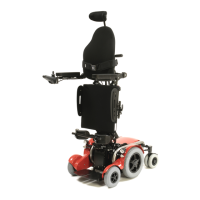Danger!
- Use a 3-point occupant restraint system to secure the occupant.
- Both pelvic and upper torso restraint belts must be used to restrain the
occupant to reduce the possibility of head and chest impacts with the vehicle
components.
- Any wheelchair anchored occupant restraint i.e. 3-point belt, harness or
postural supports (lap straps, lap belts) should not be used or relied on for
occupant restraint in a moving vehicle, regardless if labeled ISO 7176-19,
SAE J2249 or any other. Use a vehicle anchored and certified occupant
restraint system instead.
- Use a suitable positioned headrest when being transported in a wheelchair.
- Wheelchair anchored postural supports (lap straps, lap belts) should not be
used or relied on for occupant restraint in a moving vehicle.
- Occupant restraints should make full contact with the shoulder, chest and
pelvis and pelvic belts should be positioned low on the pelvis near the thigh-
abdominal junction (meeting the requirements specified in ISO 7176-
19:2008).
- The upper torso restraint belt must fit over the midpoint of shoulder and
across the chest as illustrated
- Restraint belts must be adjusted as tightly as possible consistent with user
comfort.
- Restraint belt webbing must not be twisted when in use.
- Care should be taken when applying the occupant restraint to position the
seatbelt buckle so that the release button will not be contacted by wheelchair
components while driving or during a crash.
- Belt restraints must not be held away from the body by wheelchair
components such as armrests or wheels.
Danger!
- The pelvic restraint belt must be worn low across the front of the pelvis so
that the angle of the pelvic belt is within the optional or preferred zone of
30° to 75° to the horizontal. A steeper (greater) angle within the preferred
zone, 45° to 75°is desirable i.e. closer to, but never exceeding 75° degrees.

